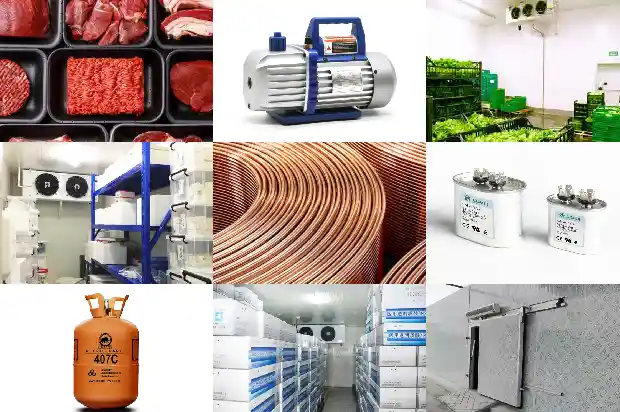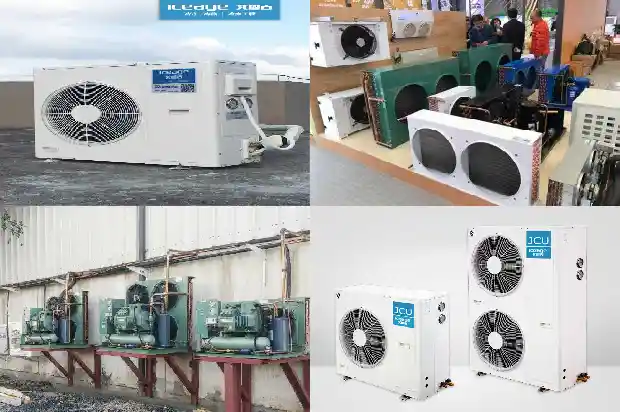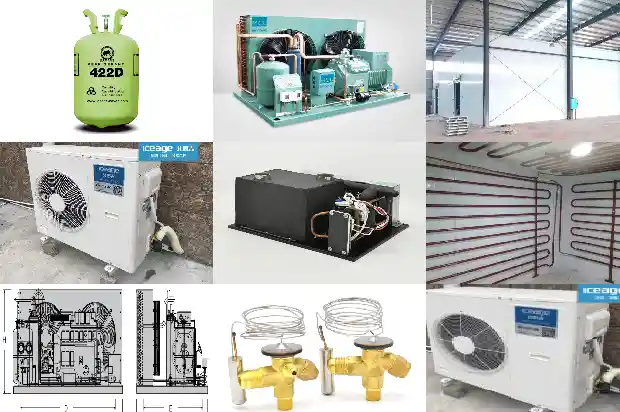What Issues Should Be Considered in the Installation of a Cold Storage?
2025-03-03
When designing a cold storage, some parameter issues need to be considered. The following summarizes the parameters that need to be collected for daily cold storage, for your reference.
First, you need to understand the following points:
First, you need to understand the following points:
- Where is the cold storage you want to build, what are the size dimensions of the cold storage or the storage quantity (length, width, height, storage quantity in tons, cubic meters, frames, boxes.
..);
- What kind of goods will be stored in the cold storage you build? Specific storage temperature, storage duration, how long it takes to reach the set temperature, etc., can all be specified and described as requirements;
- If your cold storage is relatively large, you need to know the quantity of goods entering and leaving the warehouse, the temperature of the products entering and leaving the warehouse, the number of times the door is opened, etc.;
- Once all these are clarified, it comes to the selection of materials, such as: compressors, refrigeration units, air coolers/pipe coils, thermal insulation materials, condensers, doors, temperature controllers and other refrigeration equipment.
- Commonly used cold storage panels include 50mm, 75mm, 100mm, 120mm, 150mm, 175mm, 200mm, 250mm polyurethane thermal insulation panels. The double-sided or single-sided panels are made of color steel plates, stainless steel plates, salinized steel plates, embossed aluminum plates, polyurethane spraying, etc. The most common color steel plate surface is processed into an invisible groove. It has the advantages of light weight, high strength, good thermal insulation performance, corrosion resistance, and anti-aging. This kind of storage panel is easy and quick to assemble, and is the most commonly selected material for the thermal insulation body of the cold storage. Stainless steel, salinized plates, etc. have high cost and are also prone to deformation due to friction, affecting the appearance.
- Polyurethane spraying is more commonly used in large cold storages. Different brands used by manufacturers have different prices, and the product quality also varies greatly. However, it is not always the case that high-quality products are the best. This is a conclusion drawn from long-term cooperation.
- The materials of the cold storage doors are all matched with the storage panels, but the types of doors include manual pull doors, manual sliding doors, automatic return doors, electric sliding doors, as well as sweeping doors, and there are also differences between fully embedded and semi-embedded types.
- There are many commonly used brands of compressor units. They are divided into air-cooled and water-cooled types, and also into fully enclosed and semi-enclosed types. When choosing, you must make a good comparison to find the one that best suits your price range.
- Air coolers/pipe coils: They are divided into large and small, and high and low temperature types. Pipe coils: There are aluminum coils, iron coils, etc., which are mostly used for low-temperature storage of meat products.
- Temperature control system: It adopts an advanced microcomputer control system and advanced control methods. The liquid crystal display shows the temperature inside the storage, startup time, defrosting time, fan delay time and various technical parameters. It is simple to operate and very convenient for users.
Advantages and Disadvantages of Air-Cooled/Tube-Cooled Cold Storages:
Air cooling: It has a good refrigeration effect, fast speed, a clean interior of the storage without humidity. Once the power is cut off, the temperature inside the storage is likely to be lost. It consumes electricity, has a low cost, and is easy to be renovated in the future. However, it is likely to dry out the moisture in the products, causing the products to lose weight and look less shiny. It is suitable for storing packaged vegetables and fruits, dried goods, medicines, and in restaurants and hotels, etc.
Tube cooling: The refrigeration effect is slow, there is a lot of moisture and ice cubes inside the storage, the installation is inconvenient, the cost is slightly higher, it saves electricity, and once the power is cut off, the temperature can be maintained for a certain period of time. It is not easy to be renovated. It is suitable for storing vegetables and fruits, ice creams and cold drinks, fresh meat, etc.
How to Select an Air Cooler for a Small Cold Storage
I. Air Coolers Matched with Refrigeration Cold Storages:
The load per cubic meter is calculated as W0 = 75W/m³. - If V (the volume of the cold storage) < 30m³, and for cold storages with frequent door openings, such as fresh meat cold storages, then multiply by the coefficient A = 1.2;
- If 30m³ ≤ V < 100m³, and for cold storages with frequent door openings, such as fresh meat cold storages, then multiply by the coefficient A = 1.1;
- If V ≥ 100m³, and for cold storages with frequent door openings, such as fresh meat cold storages, then multiply by the coefficient A = 1.
0;
- If it is a single refrigeration cold storage, then multiply by the coefficient B = 1.1. Finally, the selection of the air cooler for the cold storage is calculated as W = A * B * W0 (W is the load of the air cooler);
- The matching of the refrigeration unit and the air cooler of the cold storage is calculated according to the evaporation temperature of -10°C.
II. Air Coolers Matched with Freezing Cold Storages:
The load per cubic meter is calculated as W0 = 70W/m³. - If V (the volume of the cold storage) < 30m³, and for cold storages with frequent door openings, such as fresh meat cold storages, then multiply by the coefficient A = 1.2;
- If 30m³ ≤ V < 100m³, and for cold storages with frequent door openings, such as fresh meat cold storages, then multiply by the coefficient A = 1.1;
- If V ≥ 100m³, and for cold storages with frequent door openings, such as fresh meat cold storages, then multiply by the coefficient A = 1.0;
- If it is a single freezing cold storage, then multiply by the coefficient B = 1.1. Finally, the selection of the air cooler for the cold storage is calculated as W = A * B * W0 (W is the load of the air cooler).
- When the cold storage shares the refrigeration unit with the low-temperature cabinet, the matching of the unit and the air cooler is calculated according to the evaporation temperature of -35°C.
When the cold storage is separated from the low-temperature cabinet, the matching of the refrigeration unit and the air cooler of the cold storage is calculated according to the evaporation temperature of -30°C.
III. Air Coolers Matched with the Installation Room of the Cold Storage:
The load per cubic meter is calculated as W0 = 110W/m³. - If V (the volume of the processing room) < 50m³, then multiply by the coefficient A = 1.1;
- If V ≥ 50m³, then multiply by the coefficient A = 1.0. Finally, the selection of the air cooler for the cold storage is calculated as W = A * W0 (W is the load of the air cooler);
- When the processing room shares the refrigeration unit with the medium-temperature cabinet, the matching of the unit and the air cooler is calculated according to the evaporation temperature of -10°C.
When the processing room is separated from the medium-temperature cabinet, the matching of the refrigeration unit and the air cooler of the cold storage is calculated according to the evaporation temperature of 0°C. The above calculations are reference values, and the accurate calculation should be based on the load calculation of the cold storage.
Related Articles
- Comparison Issues between Air-Cooled Screw Units and Air-Cooled Modular Units
- What issues should be noted during the installation of a small - scale cold storage?
- How to Calculate Refrigeration Load? And What Are the Issues?
- What Issues Should Be Noted in Cold Storage Installation and Construction?
- Can You Solve These 4 Common Issues of Industrial Chillers?
- Frosting and Defrosting Issues of Air - cooled Heat Pumps
- Common Issues in Chiller Operation and Solutions
- Common Issues in Refrigeration Systems
- Common Issues with Refrigeration Equipment: What to Do?
- Common Issues to Pay Attention to During Cold Room Installation and Construction
- Introduction to the Components of a Cold Storage Unit and Common Issues in Cold Storage Units
- Installation, Inspection and Debugging of the Cold Storage Body
- Installation Precautions and Accessory Selection for Cold Storage Unit
- Matters Concerning the Installation of Parallel Units
- Advanced Guide! Design and Installation of Refrigeration System Pipelines
- What Are the Acceptance Standards for Cold Storage Design and Installation?
- Instructions for Welding and Drainage in the Installation of Refrigeration Equipment Pipelines
- What is the Correct Operation Method of the Distribution Box during Cold Storage Installation?
